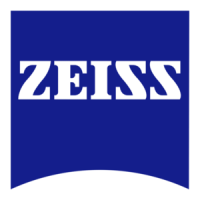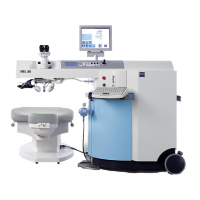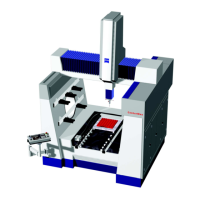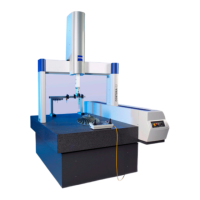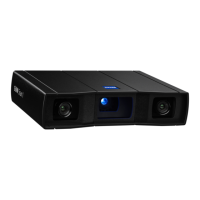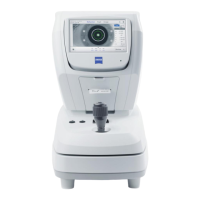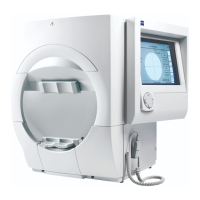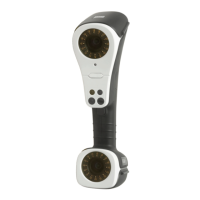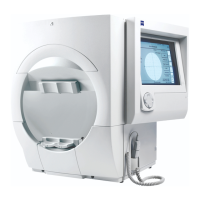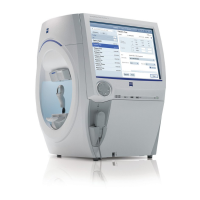Do you have a question about the Zeiss PRISMO and is the answer not in the manual?
Explains the scope and applicability of the operating instructions.
Details the structure and meaning of safety warnings and symbols used.
Defines text styles and their meaning within the document.
Covers delivery package, materials, CE marking, and relevant standards.
Outlines warranty terms, coverage, and exclusions.
Specifies the approved purpose and functions of the CMM and its components.
Details operator requirements, competence, and general safety practices.
Explains safety symbols, equipment like EMERGENCY STOP, and laser scanners.
Provides procedures for verifying the functionality of protective circuits and laser scanners.
Explains how CMMs are designated by measuring range and describes the type plate.
Illustrates the main components and design features of the PRISMO series CMM.
Details key parts like the bridge-type CMM structure, measuring table, and axes.
Describes the controller cabinet, its components, and the control console.
Introduces different types of probing systems and their applications.
Lists general specifications including dimensions, measuring range, and weight for PRISMO models.
Provides electrical data, overvoltage category, and protection class.
Details line voltage, current type, frequency, and power consumption of the MCC 800.
Specifies requirements for pressure, air quality, and air consumption.
Outlines operating temperature, humidity, and reference temperature requirements.
Refers to installation site requirements document for transport and installation measures.
Covers delivery observations, forklift requirements, ambient temperature, and transport conditions.
Discusses site selection, vibration analysis, and installation requirements.
Details initial checks, power connection, compressed air connection, and changer rack setup.
Explains the sequence for powering up the CMM, including drives and operating modes.
Guides on fastening probe holders, probes, and replacing probes.
Covers information on stylus systems and automatic stylus system change.
Provides safety instructions and procedures for workpiece setup, clamping, and handling.
Lists essential checks before operating the CMM, including probe mounting and workpiece clamping.
Introduces measuring software, operating modes, and special functions like PowerSaver.
Covers safety notes for setup, homing runs, and electromagnetic fields.
Details prerequisites for accuracy, reference point travel, and stylus qualification.
Explains how to ensure correct measurement, probing conditions, and preventing errors.
Discusses limit values for deviations and causes of measurement errors.
Guides on shutting down the CMM and preserving data.
Lists common errors during startup and their solutions.
Helps identify and resolve issues encountered during measurement runs.
Describes procedures for handling collisions, probe displacement, and contamination.
Provides information on support contact numbers and teleservice options.
Explains the purpose, types, and intervals of maintenance work.
Covers cleaning agents, safety instructions, and maintenance overview for various components.
Details steps for shutting down the CMM for extended periods.
Explains regulations for packaging and electronic component disposal.
Explains the scope and applicability of the operating instructions.
Details the structure and meaning of safety warnings and symbols used.
Defines text styles and their meaning within the document.
Covers delivery package, materials, CE marking, and relevant standards.
Outlines warranty terms, coverage, and exclusions.
Specifies the approved purpose and functions of the CMM and its components.
Details operator requirements, competence, and general safety practices.
Explains safety symbols, equipment like EMERGENCY STOP, and laser scanners.
Provides procedures for verifying the functionality of protective circuits and laser scanners.
Explains how CMMs are designated by measuring range and describes the type plate.
Illustrates the main components and design features of the PRISMO series CMM.
Details key parts like the bridge-type CMM structure, measuring table, and axes.
Describes the controller cabinet, its components, and the control console.
Introduces different types of probing systems and their applications.
Lists general specifications including dimensions, measuring range, and weight for PRISMO models.
Provides electrical data, overvoltage category, and protection class.
Details line voltage, current type, frequency, and power consumption of the MCC 800.
Specifies requirements for pressure, air quality, and air consumption.
Outlines operating temperature, humidity, and reference temperature requirements.
Refers to installation site requirements document for transport and installation measures.
Covers delivery observations, forklift requirements, ambient temperature, and transport conditions.
Discusses site selection, vibration analysis, and installation requirements.
Details initial checks, power connection, compressed air connection, and changer rack setup.
Explains the sequence for powering up the CMM, including drives and operating modes.
Guides on fastening probe holders, probes, and replacing probes.
Covers information on stylus systems and automatic stylus system change.
Provides safety instructions and procedures for workpiece setup, clamping, and handling.
Lists essential checks before operating the CMM, including probe mounting and workpiece clamping.
Introduces measuring software, operating modes, and special functions like PowerSaver.
Covers safety notes for setup, homing runs, and electromagnetic fields.
Details prerequisites for accuracy, reference point travel, and stylus qualification.
Explains how to ensure correct measurement, probing conditions, and preventing errors.
Discusses limit values for deviations and causes of measurement errors.
Guides on shutting down the CMM and preserving data.
Lists common errors during startup and their solutions.
Helps identify and resolve issues encountered during measurement runs.
Describes procedures for handling collisions, probe displacement, and contamination.
Provides information on support contact numbers and teleservice options.
Explains the purpose, types, and intervals of maintenance work.
Covers cleaning agents, safety instructions, and maintenance overview for various components.
Details steps for shutting down the CMM for extended periods.
Explains regulations for packaging and electronic component disposal.
| Brand | Zeiss |
|---|---|
| Model | PRISMO |
| Category | Measuring Instruments |
| Language | English |
